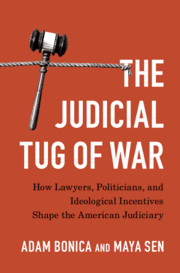 The Judicial Tug of War
The Judicial Tug of War Book contents
- Frontmatter
- Dedication
- Contents
- List of Figures
- List of Tables
- Acknowledgments
- 1 Introduction: The Tug of War Over the American Judiciary
- I The Legal Profession and the “Captured Judiciary”
- II Political Actors and the Incentive to Politicize
- 4 Politicians, Their Interests, and the Judicial Tug-of-War
- 5 Political Incentives and Politicization in the Federal Courts
- 6 Politicization in the States and Across Judicial Selection Mechanisms
- III Ramifications of the Judicial Tug-of-War
- Bibliography
- Index
- Other Books in the Series
6 - Politicization in the States and Across Judicial Selection Mechanisms
from II - Political Actors and the Incentive to Politicize
Published online by Cambridge University Press: 09 December 2020
- Frontmatter
- Dedication
- Contents
- List of Figures
- List of Tables
- Acknowledgments
- 1 Introduction: The Tug of War Over the American Judiciary
- I The Legal Profession and the “Captured Judiciary”
- II Political Actors and the Incentive to Politicize
- 4 Politicians, Their Interests, and the Judicial Tug-of-War
- 5 Political Incentives and Politicization in the Federal Courts
- 6 Politicization in the States and Across Judicial Selection Mechanisms
- III Ramifications of the Judicial Tug-of-War
- Bibliography
- Index
- Other Books in the Series
Summary
Federal courts only represent one kind of selection mechanism – appointment by the executive with the advice and consent of a legislative chamber. Because selection mechanisms vary across different jurisdictions, Chapter 6 explores how patterns may vary with regard to state courts. Indeed, part of our overall argument is that different selection mechanisms can both restrain and facilitate the incorporation of politics into judicial selection. As we show, appointments systems – like the appointments process used to name federal judges – are more sensitive to the needs and preferences of the political parties; by contrast, systems that lean toward merit-oriented criteria – including systems that are reliant on merit commissions, nonpartisan bodies, and local and state bar associations – are more sensitive to the needs and preferences of the bar. Thus, given the tension between political actors and the bar that characterizes the judicial tug of war, certain judicial selection systems may (or may not) be favorable to the different players. In other words, judicial selection mechanisms set the rules by which the tug of war is played.
Keywords
- Type
- Chapter
- Information
- The Judicial Tug of WarHow Lawyers, Politicians, and Ideological Incentives Shape the American Judiciary, pp. 173 - 212Publisher: Cambridge University PressPrint publication year: 2020


